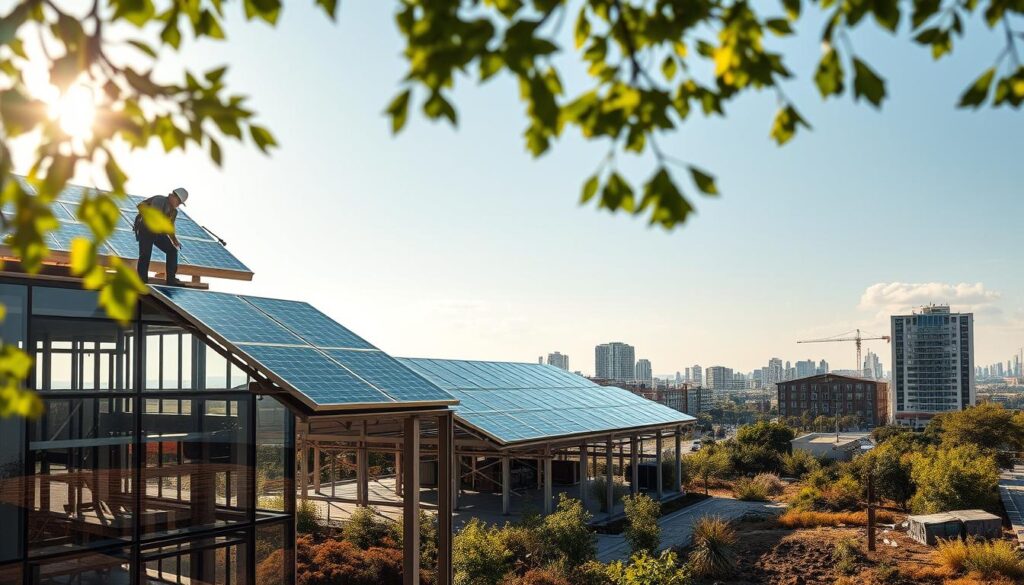Are sustainable construction practices the future of US civil engineering? As the industry continues to evolve, it’s clear that innovative approaches are needed to address the growing demand for environmentally friendly infrastructure.
The US civil engineering sector is undergoing a significant transformation with the advent of emerging green building innovations. These developments are not only beneficial for the environment but also offer economically viable solutions, paving the way for a sustainable future.
As the industry continues to adopt sustainable construction practices, it’s essential to explore the latest developments and innovations that are making a significant impact.
Key Takeaways
- The US civil engineering sector is shifting towards sustainable construction practices.
- Emerging green building innovations are transforming the industry.
- Economic viability is a key factor in the adoption of sustainable practices.
- The future of US civil engineering relies on innovative approaches.
- Sustainable infrastructure is becoming increasingly important.
Overview of Green Building Trends in the U.S.
As concern for the environment continues to grow, the U.S. construction industry is adopting green building practices at an unprecedented rate. This shift is driven by the need for eco-friendly design solutions and energy-efficient infrastructure, which not only reduce the environmental impact of buildings but also provide economic benefits through reduced energy costs.
Definition of Green Building
Green building refers to the practice of creating structures that are environmentally responsible and resource-efficient throughout their life cycle. This includes the use of sustainable materials, minimizing waste, and optimizing energy consumption. Green buildings are designed to reduce their overall impact on human health and the environment.
Importance of Sustainability in Civil Engineering
Sustainability in civil engineering is crucial as it reduces the environmental footprint of infrastructure projects. By incorporating sustainable practices, civil engineers can help minimize the depletion of natural resources, reduce pollution, and promote healthier environments for communities. The importance of sustainability is further underscored by its potential to enhance the resilience of buildings and infrastructure against the impacts of climate change.
The adoption of green building trends in the U.S. is not only a response to environmental concerns but also a strategic move towards creating more livable and sustainable communities. As the industry continues to evolve, the integration of innovative technologies and materials will play a key role in shaping the future of green building.
Key Drivers of Green Building Adoption
As the construction industry evolves, green building adoption is being driven by regulatory frameworks and consumer demand. The shift towards sustainability is not just a trend but a necessity, driven by various factors that are reshaping the civil engineering landscape.
Government Regulations and Incentives
Government initiatives play a crucial role in promoting green building practices. LEED certification requirements are among the standards that have been adopted to ensure buildings meet certain sustainability criteria. Governments offer various incentives, such as tax credits and grants, to encourage developers to incorporate green building materials and practices into their projects.
The regulatory framework supporting green building is comprehensive, involving multiple levels of government. For instance, the U.S. Green Building Council (USGBC) has been instrumental in promoting LEED certification across the country. This certification not only enhances the marketability of a building but also contributes to its environmental sustainability.
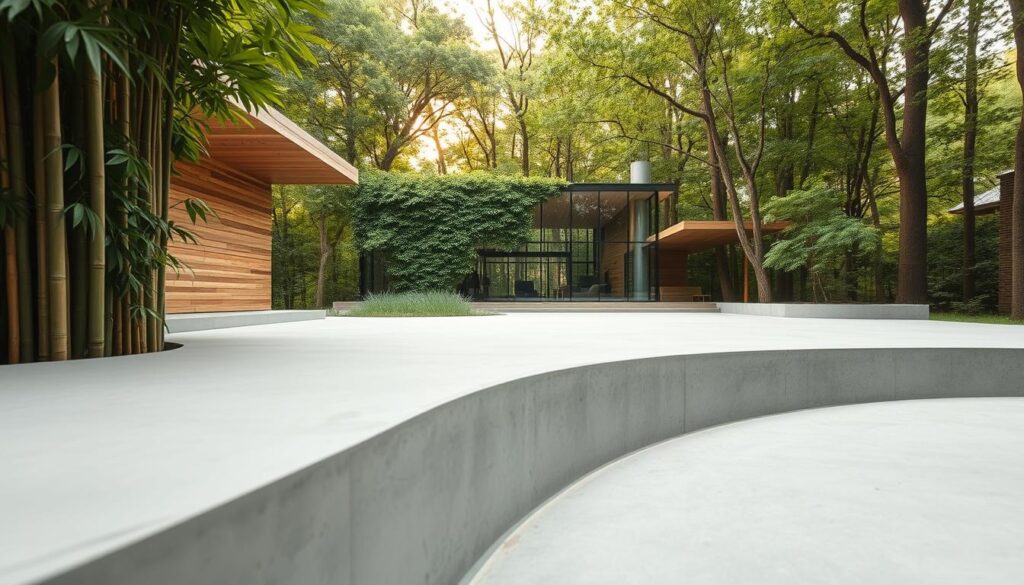
Market Demand for Sustainable Practices
There is a growing demand for sustainable practices in the construction industry, driven by both consumers and businesses. The market for green building materials is expanding as developers seek to reduce the environmental footprint of their projects. This demand is not just driven by regulatory compliance but also by the desire to create healthier, more efficient buildings.
The economic benefits of green building, such as reduced energy costs and increased property values, are also significant drivers. As awareness of these benefits grows, so does the demand for green buildings, creating a positive feedback loop that is expected to continue driving the adoption of sustainable practices in the industry.
Renewable Energy Integration in Civil Engineering
Renewable energy is becoming a cornerstone in the development of sustainable civil engineering projects. As the world shifts towards reducing carbon footprints, the integration of renewable energy sources into civil engineering is not just a trend, but a necessity.
The use of renewable energy in civil engineering encompasses various technologies, including solar and wind power. These energy sources are pivotal in creating energy-efficient infrastructure that supports urban sustainability initiatives.
Solar Energy Solutions
Solar energy is one of the most accessible forms of renewable energy. In civil engineering, solar energy solutions are being integrated into building designs to power homes, offices, and public infrastructure.
“The future of energy lies in harnessing the power of the sun,” says a leading expert in renewable energy. “With advancements in solar panel technology, we can now integrate solar energy harvesting into building structures seamlessly.”
“As we move forward, the challenge is not just about adopting new technologies, but about creating a sustainable infrastructure that can support the growing energy demands of our cities.”
Solar energy solutions include photovoltaic (PV) systems that convert sunlight into electricity. These systems can be integrated into rooftops, facades, and even roads, providing a versatile range of applications.
Wind Power Applications
Wind power is another critical component of renewable energy integration in civil engineering. Wind turbines are being used to generate electricity, reducing reliance on fossil fuels.
Wind power applications in civil engineering include both onshore and offshore wind farms. These installations require careful planning and execution to maximize energy production while minimizing environmental impact.
The benefits of wind power are multifaceted, including reduced greenhouse gas emissions and the creation of jobs in the renewable energy sector. As technology advances, the efficiency and output of wind turbines continue to improve, making wind power an increasingly viable option for energy production.
By integrating renewable energy sources like solar and wind power into civil engineering projects, we can create more sustainable and resilient infrastructure. This not only supports environmental goals but also enhances the quality of life in urban areas.
Smart Building Technologies
Smart building technologies are transforming the way buildings are designed, operated, and maintained across the U.S. These technologies are pivotal in enhancing energy efficiency, reducing environmental impact, and improving occupant comfort.
IoT and Building Management Systems
The integration of Internet of Things (IoT) devices with building management systems (BMS) is a significant advancement in smart building technology. IoT devices can monitor and control various building systems, including lighting, heating, ventilation, and air conditioning (HVAC), and security systems. This integration enables real-time data collection and analysis, allowing for optimized building performance and energy efficiency.
Key Benefits of IoT in BMS:
- Enhanced energy management through real-time monitoring
- Improved occupant comfort through personalized settings
- Predictive maintenance to reduce downtime and extend equipment life
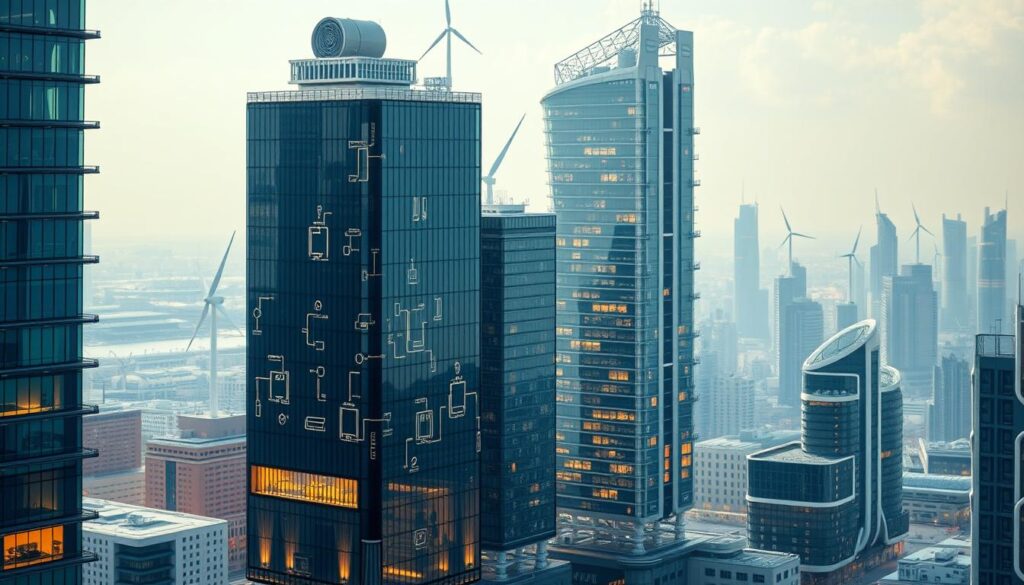
Energy Efficiency Solutions
Energy efficiency is a critical aspect of smart building technologies. Advanced solutions such as energy-efficient lighting, smart HVAC systems, and energy management software are being adopted to reduce energy consumption. These solutions not only lower operational costs but also contribute to environmental sustainability.
| Energy Efficiency Solution | Description | Benefits |
|---|---|---|
| Smart Lighting | Automated lighting systems that adjust based on occupancy and daylight availability | Reduced energy consumption, lower utility bills |
| Advanced HVAC Systems | High-efficiency heating, ventilation, and air conditioning systems with smart controls | Improved indoor air quality, reduced energy usage |
| Energy Management Software | Software that monitors and analyzes energy usage in real-time | Identifies areas for energy savings, optimizes energy consumption |
By adopting these smart building technologies, the U.S. civil engineering sector can significantly mitigate environmental impact while enhancing the sustainability and efficiency of buildings.
Sustainable Materials and Construction Practices
Green building innovations are largely driven by the adoption of sustainable materials and construction methods. The construction industry is increasingly recognizing the importance of reducing its environmental footprint through the use of eco-friendly materials and practices.
Low-Impact and Recyclable Materials
The use of low-impact and recyclable materials is a crucial aspect of sustainable construction. Materials such as recycled steel, bamboo, and low-VOC (Volatile Organic Compound) paints are becoming more popular due to their reduced environmental impact.
- Recycled Steel: Reduces the need for virgin materials and minimizes waste.
- Bamboo: A highly renewable resource with a low environmental impact.
- Low-VOC Paints: Improves indoor air quality by reducing VOC emissions.
These materials not only contribute to a more sustainable building process but also offer benefits such as improved energy efficiency and enhanced indoor air quality.
Prefabrication Techniques
Prefabrication techniques are gaining popularity in the construction industry due to their potential to reduce waste, improve quality, and increase efficiency. Prefabricated modules are manufactured in a controlled environment, reducing the environmental impact of on-site construction.
Benefits of Prefabrication include:
- Reduced construction time
- Minimized on-site waste
- Improved quality control
The following table highlights some common sustainable materials and their benefits:
| Material | Benefits | Applications |
|---|---|---|
| Recycled Steel | Reduces waste, energy-efficient | Structural framing, roofing |
| Bamboo | Highly renewable, durable | Flooring, wall cladding |
| Low-VOC Paints | Improves indoor air quality | Interior walls, ceilings |
The Role of LEED Certification
LEED certification has become a cornerstone in the U.S. green building movement, transforming how civil engineers design and construct sustainable projects. By providing a framework for designing, constructing, and operating sustainable buildings, LEED certification is pivotal in promoting green building practices.
LEED, or Leadership in Energy and Environmental Design, is a widely recognized standard that evaluates the environmental performance of a building. It encourages the use of sustainable construction practices, reducing the environmental footprint of buildings.
Understanding LEED Standards
LEED standards are comprehensive, covering various aspects of green building, including energy efficiency, water conservation, and material selection. To achieve LEED certification, projects must meet specific LEED certification requirements, which include:
- Implementing energy-efficient systems to reduce energy consumption.
- Using sustainable materials and resources.
- Enhancing indoor environmental quality.
- Innovating in design and operations.
Projects are awarded points based on their compliance with these criteria, with different levels of certification (Certified, Silver, Gold, and Platinum) depending on the total points earned.
Benefits of LEED Certification for Projects
LEED certification offers numerous benefits for projects, enhancing their credibility and value. Some of the key advantages include:
| Benefit | Description |
|---|---|
| Marketability | LEED-certified buildings are more attractive to tenants and buyers due to their sustainable features. |
| Energy Efficiency | LEED-certified buildings typically have lower energy costs due to efficient systems. |
| Environmental Impact | LEED certification promotes sustainable construction practices, reducing the environmental footprint. |
By adopting LEED certification, civil engineers and project developers can not only contribute to a more sustainable future but also enhance the marketability and efficiency of their projects.
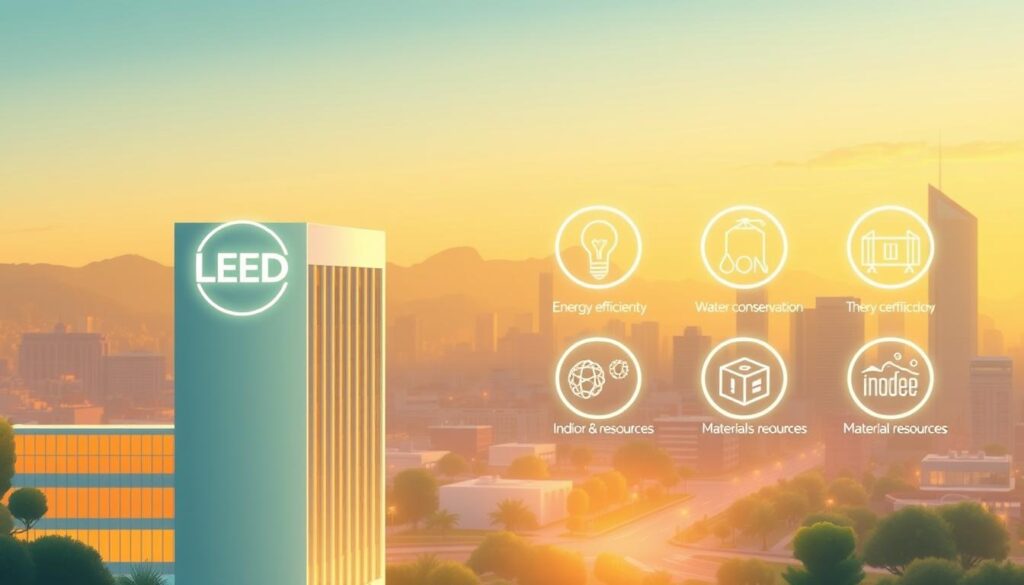
In conclusion, LEED certification plays a vital role in promoting sustainable construction practices and enhancing the value of green building projects. As the U.S. continues to adopt more sustainable practices, the importance of LEED certification is likely to grow.
Resilient Infrastructure Development
As the world grapples with the challenges of climate change, resilient infrastructure development has become a critical component of sustainable urban planning. The need to adapt to climate change and enhance community resilience has never been more pressing.
Climate Change Adaptation Strategies
Adapting to climate change requires a multifaceted approach that includes implementing environmental impact mitigation strategies. This involves designing infrastructure that can withstand the impacts of climate change, such as sea-level rise, extreme weather events, and changing precipitation patterns.
“Investing in resilient infrastructure is not just about protecting physical assets; it’s about safeguarding the well-being of communities,” says an expert in urban sustainability. Effective climate change adaptation strategies can significantly reduce the vulnerability of communities to climate-related hazards.
Enhancing Community Resilience
Enhancing community resilience is a key aspect of urban sustainability initiatives. This involves not only building resilient infrastructure but also fostering community engagement and education on climate change and its impacts.
- Implementing green infrastructure to manage stormwater runoff
- Developing early warning systems for extreme weather events
- Promoting community-led adaptation initiatives
By integrating these strategies into urban planning, cities can enhance their resilience to climate change, ensuring a safer and more sustainable future for their residents.
Water Conservation Strategies in Building Projects
Green building initiatives in the US are increasingly focusing on innovative water conservation methods. Water conservation is a critical aspect of sustainable development, reducing the strain on municipal water supplies and lowering the energy required to treat and transport water.
Effective water conservation strategies not only benefit the environment but also offer significant cost savings for building owners and occupants. As such, integrating water-saving technologies and practices into building projects is becoming a priority.
Rainwater Harvesting Systems
Rainwater harvesting systems collect and store rainwater for various uses, including irrigation, toilet flushing, and even potable water. These systems can significantly reduce a building’s water footprint.
Implementation of rainwater harvesting involves assessing the building’s water needs, designing an appropriate collection system, and ensuring proper treatment and storage of the harvested rainwater.
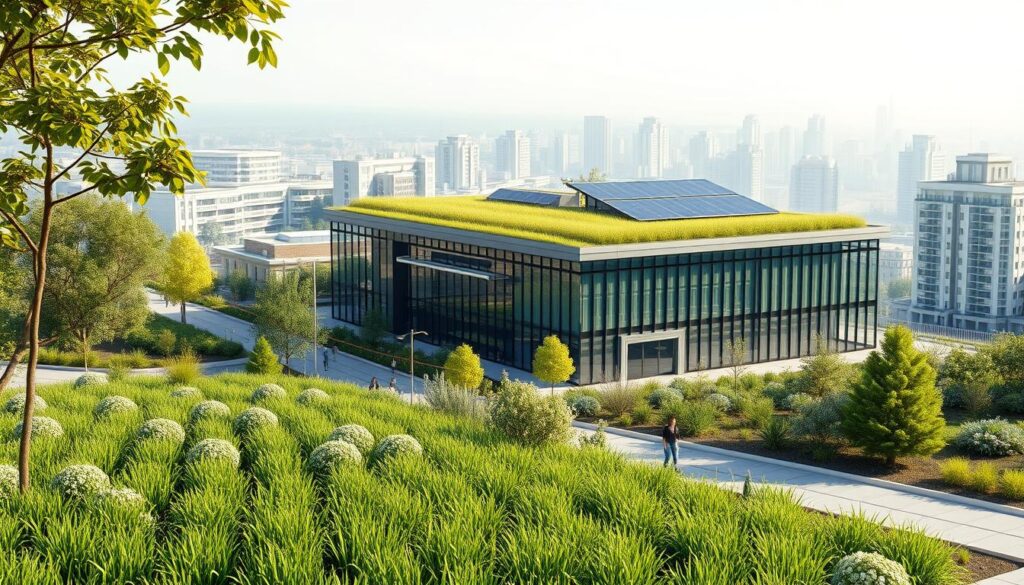
Efficient Irrigation Techniques
Efficient irrigation techniques are crucial for minimizing water waste in landscaping. Techniques such as drip irrigation and the use of drought-resistant plants can significantly reduce water consumption.
Smart irrigation controllers can further optimize water use by adjusting irrigation schedules based on weather conditions, soil moisture levels, and plant water requirements.
The Impact of Biophilic Design
Incorporating natural elements into architectural designs is not just aesthetically pleasing but also beneficial for occupants. Biophilic design, which focuses on bringing nature into buildings, is transforming the construction industry by promoting eco-friendly design solutions and sustainable construction practices.
Benefits of Incorporating Nature
Bringing nature into building design has numerous benefits, including improved air quality, enhanced biodiversity, and increased occupant satisfaction. Studies have shown that exposure to natural elements can boost productivity and well-being among building occupants.
The benefits of biophilic design can be seen in various aspects:
- Improved mental health and well-being
- Enhanced creativity and productivity
- Better air quality and reduced stress levels
- Increased connection to nature
Enhancing Indoor Environments
Biophilic design enhances indoor environments by incorporating natural light, ventilation, and elements of nature. This not only improves the aesthetic appeal of a building but also creates healthier spaces for occupants.
Some effective ways to enhance indoor environments through biophilic design include:
- Incorporating green walls and roofs
- Using natural materials in construction
- Maximizing natural light through strategic window placement
A notable example of biophilic design is the Amazon Spheres in Seattle, which features over 40,000 plants from around the world. This building not only provides a unique workspace but also improves air quality and enhances biodiversity.
| Biophilic Design Element | Benefits | Examples |
|---|---|---|
| Natural Light | Improved mood, reduced energy consumption | Skylights, large windows |
| Green Walls/Roofs | Enhanced air quality, biodiversity | Living walls, rooftop gardens |
| Natural Materials | Aesthetic appeal, sustainability | Wood, stone, bamboo |
Community Engagement in Green Building
By engaging with the community, green building projects can better meet the needs of the local population. Community engagement is essential for promoting urban sustainability initiatives and mitigating the environmental impact of construction projects.
Involving Stakeholders
Involving stakeholders is a critical aspect of community engagement in green building. This includes not only the local community but also investors, architects, and government agencies. Effective stakeholder engagement can be achieved through various means, such as public meetings, surveys, and collaborative planning processes.
- Public meetings to discuss project plans and gather feedback
- Surveys to understand community needs and preferences
- Collaborative planning processes to ensure all stakeholders are aligned
By involving stakeholders, green building projects can gain valuable insights and support, ultimately leading to more successful outcomes.
Educational Initiatives for Sustainability
Educational initiatives play a vital role in promoting sustainability and green building practices within the community. These initiatives can take many forms, including workshops, training programs, and public awareness campaigns.
“Education is the key to unlocking the potential for sustainable development.” – This quote emphasizes the importance of educating the community about green building practices.
Some effective educational initiatives include:
- Workshops on sustainable building techniques
- Training programs for local contractors and builders
- Public awareness campaigns to promote the benefits of green building
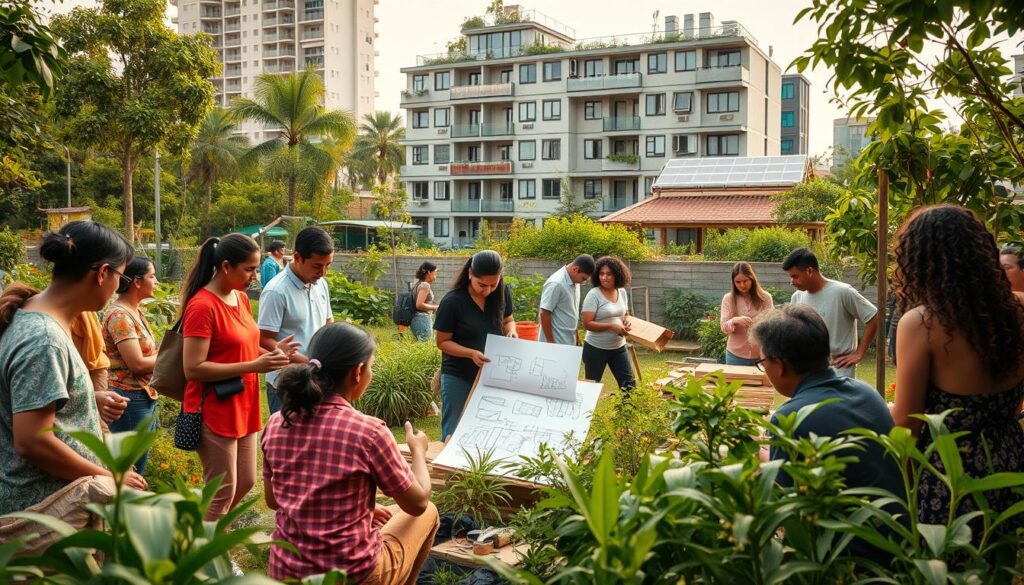
By implementing these educational initiatives, communities can foster a culture of sustainability and support the adoption of green building practices.
Innovations in Waste Management
Innovations in waste management are transforming the construction sector, enabling more sustainable and environmentally friendly practices. The construction industry is one of the largest producers of waste, and effective waste management strategies are crucial for reducing its environmental footprint.
Construction Waste Recycling
Construction waste recycling is a significant innovation in waste management. It involves the processing and reuse of construction materials such as concrete, wood, and metal. This approach not only reduces the amount of waste sent to landfills but also conserves natural resources by decreasing the need for new raw materials.
Benefits of Construction Waste Recycling:
- Reduces landfill waste
- Conserves natural resources
- Decreases the environmental impact of extracting and processing raw materials
| Material | Recycling Method | Benefits |
|---|---|---|
| Concrete | Crushing and reuse as aggregate | Reduces need for virgin aggregate, saves landfill space |
| Wood | Reusing or recycling into mulch or biofuel | Reduces deforestation, provides alternative energy sources |
| Metal | Melting and reforming into new products | Conserves metal resources, reduces energy consumption |
Composting and Organic Waste Solutions
Composting and organic waste solutions are another critical aspect of innovations in waste management. These practices involve the decomposition of organic materials such as food waste and yard trimmings into compost, which can be used as a nutrient-rich soil amendment.
Advantages of Composting:
- Reduces the amount of organic waste sent to landfills
- Creates a valuable resource for agriculture and landscaping
- Helps in reducing greenhouse gas emissions by minimizing the production of methane in landfills
Implementing these innovations in waste management requires a coordinated effort from construction companies, policymakers, and the community. By adopting sustainable construction practices and green building materials, the construction industry can significantly reduce its environmental impact.
The Future of Transportation in Green Buildings
The integration of sustainable transportation solutions is becoming a cornerstone of modern green buildings. As urban areas continue to grow, the need for efficient, eco-friendly transportation systems is becoming increasingly important.

Electric Vehicle Charging Stations
One of the key components of sustainable transportation in green buildings is the incorporation of electric vehicle (EV) charging stations. These charging stations not only support the adoption of electric vehicles but also contribute to reducing carbon emissions. By installing EV charging infrastructure, green buildings can attract eco-conscious residents and visitors, enhancing their appeal and value.
Benefits of EV Charging Stations:
- Encourages the use of electric vehicles, reducing reliance on fossil fuels.
- Enhances the attractiveness of green buildings to environmentally aware consumers.
- Supports the development of energy-efficient infrastructure.
Sustainable Transit-Oriented Development
Sustainable transit-oriented development (TOD) is another crucial aspect of the future of transportation in green buildings. TOD involves designing communities around public transportation hubs, reducing the need for personal vehicles and promoting more sustainable modes of transport. This approach not only decreases traffic congestion but also fosters more livable, vibrant communities.
Key elements of TOD include:
- Compact, walkable neighborhoods centered around transit hubs.
- Mixed-use development that combines residential, commercial, and recreational spaces.
- Enhanced public transportation options, such as buses and trains.
By integrating EV charging stations and sustainable TOD, green buildings can significantly contribute to urban sustainability initiatives, creating a more sustainable and environmentally friendly transportation network.
Case Studies of Successful Green Building Projects
The adoption of green building practices in the U.S. has resulted in numerous exemplary projects that highlight the benefits of sustainable construction. These projects not only demonstrate environmental stewardship but also showcase economic and social benefits.
Notable Projects Across the U.S.
Several green building projects across the United States have gained recognition for their innovative approaches to sustainability. For instance, the One World Trade Center in New York City is a prime example of green building, featuring a number of sustainable design elements, including a rainwater collection system and energy-efficient lighting.
Another notable project is the Bullitt Center in Seattle, Washington, which is considered one of the greenest commercial buildings in the world. It boasts a rooftop solar array, rainwater harvesting, and composting toilets, among other sustainable features.
- The Edge in Amsterdam, while not in the U.S., has influenced U.S. projects with its BREEAM Outstanding certification and innovative use of technology for sustainability.
- The Phyllis Young Takahashi Memorial Library at the University of Hawaii at Manoa has achieved LEED Gold certification through its use of sustainable materials and energy-efficient systems.
Lessons Learned and Best Practices
These successful green building projects provide valuable insights into best practices for sustainable construction. Key lessons include the importance of integrating green building technologies from the outset, engaging stakeholders in the sustainability process, and selecting materials that are both sustainable and durable.
- Early integration of green building strategies can significantly enhance the overall sustainability of a project.
- Stakeholder engagement is crucial for the successful implementation of green building practices.
- The use of sustainable materials not only reduces environmental impact but can also improve indoor air quality and occupant health.
By examining these case studies, civil engineers and developers can gain a deeper understanding of how to effectively implement green building practices in their own projects, contributing to a more sustainable built environment.
Conclusion: The Future of Green Building in Civil Engineering
The future of green building in civil engineering is promising, with various trends and innovations emerging to support sustainable construction practices and mitigate environmental impact. As the industry continues to evolve, it is essential to stay informed about the latest developments and strategies.
Emerging Trends
Some of the key trends to watch include the increased adoption of renewable energy sources, advancements in smart building technologies, and the use of sustainable materials in construction projects. These trends are expected to play a crucial role in reducing the environmental footprint of buildings and promoting eco-friendly practices.
Mitigating Environmental Impact
Effective environmental impact mitigation strategies will be critical in the future of green building. This includes implementing waste reduction and recycling programs, using low-impact materials, and incorporating biophilic design elements to enhance indoor environments. By adopting these strategies, the civil engineering industry can continue to move towards a more sustainable future.
